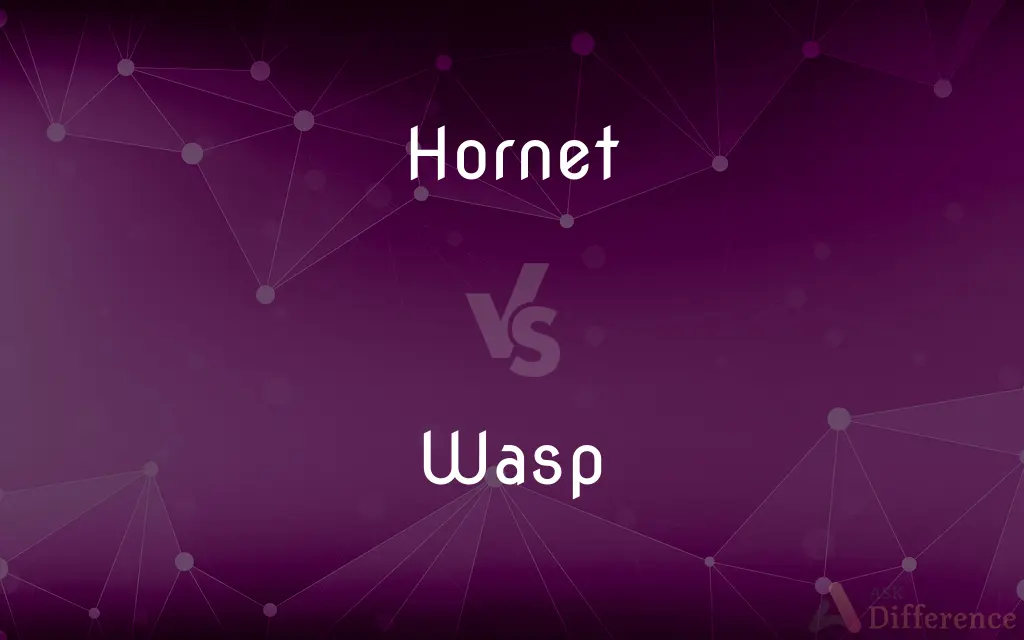Hornet vs. Wasp — What's the Difference?
By Tayyaba Rehman — Updated on September 22, 2023
A hornet is a large, aggressive type of wasp; the term "wasp" generally refers to any member of the Hymenoptera insect order, distinguished by a narrow waist.

Difference Between Hornet and Wasp
Table of Contents
ADVERTISEMENT
Key Differences
Hornets and wasps are members of the Hymenoptera order, but hornets are considered a subset of wasps, known for their larger size and more aggressive nature. Hornets, possessing powerful stings, are often more feared, and their nests are usually located in trees or shrubs. They are social insects, and their colonies are composed of queens, workers, and males. The robust structure and communal nature of hornets make them formidable and notable within ecosystems.
Wasps, on the other hand, are a diverse group encompassing a wide range of species, sizes, and behaviors. Some wasps are solitary, while others form colonies. Wasps are recognized for their narrow waists and are varied in their feeding habits, with some preying on other insects and some consuming nectar. The diversity within wasp species impacts the environments they inhabit, contributing to ecological balance and pest control.
The differences between hornets and wasps extend to their ecological roles. Hornets, being larger and more aggressive, predominantly prey on other insects, controlling their populations. Their presence is essential in maintaining ecological balance by reducing the numbers of potential pest insects. Wasps, due to their diverse diet, play a dual role as pollinators and as predators, contributing significantly to the sustenance of floral biodiversity and the regulation of insect populations.
Both hornets and wasps can be beneficial to humans by controlling pest populations and pollinating plants. However, their stings can be painful and, in some cases, dangerous, causing allergic reactions in some individuals. It is crucial to approach areas inhabited by hornets and wasps with caution and to manage their presence responsibly, considering their ecological importance.
The behavioral, anatomical, and ecological differences between hornets and wasps are significant, despite their relatedness. A thorough understanding of these differences is essential to appreciate their roles in ecosystems and to handle interactions with them responsibly and safely.
ADVERTISEMENT
Comparison Chart
Size
Larger.
Varies, generally smaller.
Aggression
More aggressive.
Less aggressive, varies by species.
Diet
Predominantly other insects.
Varied; can include nectar and other insects.
Nesting
Typically in trees or shrubs.
Variety of locations including underground.
Role
Primarily predator.
Can be predator or pollinator.
Compare with Definitions
Hornet
A hornet is a large, stinging, social wasp.
The hornet buzzed loudly, alerting us to its presence.
Wasp
They can be solitary or social, depending on the species.
The solitary wasp preferred to nest alone.
Hornet
It's known for its aggressive protection of its nest.
The hornet attacked when we approached its nest.
Wasp
A wasp is any insect of the order Hymenoptera and suborder Apocrita that is neither a bee nor an ant.
The wasp flew away after sipping nectar from the flower.
Hornet
Hornets are beneficial due to their role in controlling other insect populations.
The hornet helps maintain ecological balance by preying on pests.
Wasp
It’s known for its narrow waist and varied diet.
The wasp captured a spider to feed its larvae.
Hornet
Hornets typically have a black and white or brownish coloration.
The hornet's distinctive coloration sets it apart from many other wasp species.
Wasp
Wasps play crucial ecological roles as pollinators and predators.
The wasp contributes to the pollination of several plant species.
Hornet
Hornets (insects in the genus Vespa) are the largest of the eusocial wasps, and are similar in appearance to their close relatives yellowjackets. Some species can reach up to 5.5 cm (2.2 in) in length.
Wasp
A wasp is any insect of the narrow-waisted suborder Apocrita of the order Hymenoptera which is neither a bee nor an ant; this excludes the broad-waisted sawflies (Symphyta), which look somewhat like wasps but are in a separate suborder. The wasps do not constitute a clade, a complete natural group with a single ancestor, as their common ancestor is shared by bees and ants.
Hornet
Any of various large stinging wasps of the family Vespidae, chiefly of the genera Vespa and Vespula, that characteristically build large papery nests.
Wasp
A white person of Protestant English or other Northern European ancestry, especially one belonging to the American upper class.
Hornet
A large wasp, of the genus Vespa, having a brown-and-yellow-striped body and the ability to inflict a serious sting.
Wasp
A member of Women's Airforce Service Pilots, organized during World War II as part of the US Army Air Forces to ferry aircraft and to test new aircraft. The organization was disbanded in 1944.
Hornet
A person who pesters with petty but ceaseless attacks.
Wasp
Any of numerous social or solitary hymenopterans of the suborder Apocrita, especially of the family Vespidae, that characteristically have a slender hairless body with a constricted abdomen, two pairs of membranous wings, a mouth adapted for biting or sucking, and in the females an ovipositor sometimes modified as a sting.
Hornet
A large, strong wasp. The European species (Vespa crabro) is of a dark brown and yellow color. It is very pugnacious, and its sting is very severe. Its nest is constructed of a paperlike material, and the layers of comb are hung together by columns. The American white-faced hornet (Vespa maculata) is larger and has similar habits.
Wasp
Any of many types of stinging flying insect resembling a hornet.
Hornet
Large stinging paper wasp
Wasp
(entomology) Any of the members of suborder Apocrita, excepting the ants (family Formicidae) and bees (clade Anthophila).
Hornet
It is distinguishable by its sizable body and powerful sting.
The hornet’s sting can be more painful than that of other wasps.
Wasp
Any of the members of the family Vespidae.
Wasp
A person who behaves in an angry or insolent way, hence waspish.
Wasp
Alternative case form of WASP
Wasp
To move like a wasp; to buzz
Wasp
Any one of numerous species of stinging hymenopterous insects, esp. any of the numerous species of the genus Vespa, which includes the true, or social, wasps, some of which are called yellow jackets.
Wasp
A white person of Anglo-Saxon ancestry who belongs to a Protestant denomination
Wasp
Social or solitary hymenopterans typically having a slender body with the abdomen attached by a narrow stalk and having a formidable sting
Wasp
Wasps can be beneficial by controlling pest populations.
The wasp’s predatory nature helps in controlling the number of garden pests.
Common Curiosities
Is a hornet a type of wasp?
Yes, a hornet is a large, aggressive type of wasp.
Can hornet and wasp stings be fatal?
Rarely, stings can be fatal due to allergic reactions, but this is uncommon.
How do hornets and wasps differ in nesting?
Hornets often nest in trees or shrubs, while wasp nests can be found in a variety of locations.
Are hornets more dangerous than wasps?
Hornets are generally more aggressive and have more painful stings than most wasps.
Do hornets and wasps live in colonies?
Hornets live in colonies, and some wasp species are social and live in colonies, while others are solitary.
Are hornets beneficial to the ecosystem?
Yes, they control other insect populations, maintaining ecological balance.
Do both hornets and wasps pollinate flowers?
Yes, but the extent varies, with some wasp species being more efficient pollinators.
Are all wasps aggressive?
Aggression varies by species; some are aggressive, while others are more docile.
Share Your Discovery

Previous Comparison
Professor vs. Don
Next Comparison
Launch vs. LunchAuthor Spotlight
Written by
Tayyaba RehmanTayyaba Rehman is a distinguished writer, currently serving as a primary contributor to askdifference.com. As a researcher in semantics and etymology, Tayyaba's passion for the complexity of languages and their distinctions has found a perfect home on the platform. Tayyaba delves into the intricacies of language, distinguishing between commonly confused words and phrases, thereby providing clarity for readers worldwide.















































